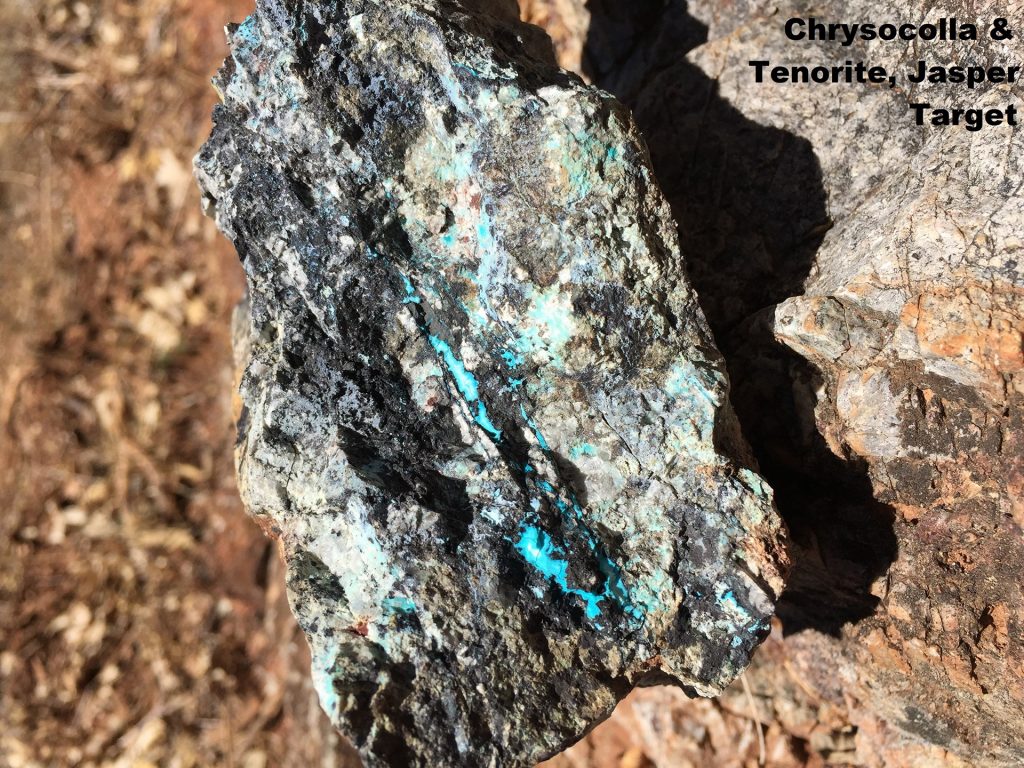Vancouver, Canada – April 16, 2019 – Aztec Minerals Corp. (AZT: TSX-V, OTCQB: AZZTF) reports that interpretation of the recently completed airborne magnetic and radiometric survey data has interpreted multiple high-quality undrilled porphyry gold-copper targets on the Cervantes property in Sonora, Mexico.
The California mineralized zone drilled by Aztec sits in a radiometric K/Th anomaly and a magnetic embayment adjacent to a magnetic high, both interpreted to represent the quartz feldspar porphyry (QFP) host rock and related k-phyllic alteration associated with mineralization.
New targets were also identified such as the Estrella Target, a substantial 1.3 km by 3.0 km series of northwest-southeast trending magnetic highs composed of outcropping pyrrhotite-pyrite-chalcopyrite bearing hornfels (sediments baked by their proximity to an intrusion) paired with 3 distinct magnetic highs interpreted to be altered QFP intrusions.
Joey Wilkins, President and CEO, commented, “We are very pleased to see the airborne geophysical survey at Cervantes successfully identified 11 prospective porphyry target areas, including several newly discovered high-quality targets. Pronounced northeast-southwest trends are enhanced in the new geophysical datasets in addition to clear northwest-southeast trends we believe are important mineralizing controls. We plan to follow up each prospect area with more detailed mapping, sampling and surveying to better define targets for drilling.”
Eleven target zones were confirmed by the airborne geophysical surveys, as can be seen on the magnetic and radiometric maps (map #1, map #2) and the four main targets are summarized below:
- California is flanked by a substantial magnetic high on the east side, two magnetic anomalies on the southeast side, and sits in a lower magnetic embayment where the strongest alteration and mineralization were mapped, sampled and drilled by Aztec. The phyllic-argillic alteration is thought to have destroyed any magnetite in the QFP, typical of mineralized porphyry systems. There are no magnetic rocks on the surface nor in the drill core, thus the adjacent large-scale magnetic high is interpreted to be a larger intrusion, possibly with potassic-magnetite alteration. The IP chargeability high related to sulfide mineralization correlates well with both magnetic lows and highs and the resistivity high correlates to magnetic highs typically associated with intrusions. The strong chargeability high and strong magnetic high are both appealing drill targets
- Estrella is located between Purisima East and Jasper, marked by a prominent 3.0 km long by 1.0 km wide, NW-SE trending, strong magnetic high, about 65% covered by andesitic volcanics sitting on top of a low angle fault, thus prospective targets may exist below the andesites. Outcrops of hornfels containing pyrrhotite, pyrite, and chalcopyrite are found throughout the target area with QFP dikes. Three parallel but unique magnetic anomalies are interpreted to be buried intrusions, one of which outcrops towards the north as QFP and returned rock samples grading up to 3.91 gpt gold and 0.2% copper, an excellent drill target
- California North is a substantial magnetic high associated with an IP chargeability high forming a thick rind to the magnetic high at depth, providing an attractive target
- Purisima East is a moderate to weak magnetic anomaly within a circular feature, interpreted to be a diatreme body, with a very high radiometric anomaly, indicative of a high-level intrusion
The magnetic data reveal multiple magnetic highs distributed along a NE-SW trend covering 8.0 kilometers and two distinct but separate anomalies along a NW-SE trend with dimensions of 2.0 and 3.0 kilometers. The magnetic data described herein is the analytical signal which provides the amplitude of magnetism close its actual position rather than the direction of magnetism which can be skewed. The largest anomalies are related to California and a new target called Estrella. The Jacobo is robust and Bohemia/La Verde anomaly is new, possibly related to an intrusive body.
The radiometric data strongly highlight the prominent NE-SW trend of the known targets (Jacobo-Purisima-California) in addition to showing the NW-SE targets such as Estrella and Bohemia/La Verde. The Total Count or TC is a combination of the potassium, thorium, and uranium values that typically reflect felsic intrusions. The potassium/thorium (K/Th) ratio highlights the highest potassium values that typically reflect porphyry alteration. K/Th prominently shows the Jacobo and two Purisima targets (East and West), while California has a more subdued but anomalous radiometric footprint. The subdued radiometric response at California is interpreted to be due to a deeper level of erosion into the system relative to the other targets, which therefore may have less erosion and more target to drill-test.
The detailed interpretation has unified our thoughts that Cervantes has multiple porphyry cells aligned along a northeast-southwest orientation, manifested as high-level alteration footprints related to intrusive bodies. There are also prominent northwest-southeast trending magnetic anomalies found to be associated with strong alteration, gold-copper mineralization, and intrusive rocks. The best filters to work with have been the analytical signal (AS) and first vertical derivative (1st VD) with the AS highlighting the true amplitude of the magnetism rather than the direction and thought to represent the truer location. The AS data was reviewed in conjunction with surface geochemistry, geology, alteration, and induced polarization (IP) data thus becoming a powerful tool for identifying drill targets.
The new data has confirmed our prediction of a new district centered partly on the California target with multiple surrounding targets, new and old, that have excellent magnetic to radiometric anomalies and interpretation suggest several are drill targets, to be confirmed once further work such as detailed mapping, rock and soil sampling, and possible IP geophysics.
QP Disclosure – The geophysical survey was flown by Terraquest Ltd in December, 2018 and the full dataset and report received in February 2019. The dataset includes radiometrics, magnetics, and VLF. The radiometric data consists of images of potassium, thorium, and uranium along with ternary composite or total count of the data. The magnetic data was leveled therein creating a total magnetic intensity (TMI) dataset from which filters were applied producing analytical signal (AS) and first vertical derivative (1st VD). Additional and minor data post-processing was conducted by Computational Geoscience Inc, specifically the K/Th ratio from the radiometrics and a reduced to pole filter from the TMI. Joey Wilkins, P.G., is the Qualified Person who reviewed and approved the technical disclosures herein.
About Aztec Minerals – Aztec is a mineral exploration company focused on the discovery of large deposits in the Americas. Our core asset is the prospective Cervantes porphyry gold-copper property in Sonora, Mexico, where the company can acquire 100%. Our district-scale historic Tombstone properties hold both bulk tonnage epithermal gold-silver as well as CRD silver-lead-zinc deposits in Cochise County, Arizona. Aztec’s shares trade on the TSX-V stock exchange (symbol AZT) and on the OTCQB (symbol AZZTF).
Contact Information – For more information, please contact:
Neil MacRae, Vice President, Investor Relations
Tel: (604) 685-9770
Fax: (604) 685-9744
Email: neil@aztecminerals.com
Website: www.aztecminerals.com
Neither the TSX Venture Exchange nor its Regulation Services Provider (as that term is defined in the policies of the TSX Venture Exchange) accepts responsibility for the adequacy or accuracy of this release. No stock exchange, securities commission or other regulatory authority has approved or disapproved the information contained herein.
Cautionary Note Regarding Forward-Looking Statements
This news release contains “forward-looking statements” within the meaning of the United States Private Securities Litigation Reform Act of 1995 and “forward-looking information” within the meaning of applicable Canadian securities legislation. Such forward?looking statements and information herein include but are not limited to statements regarding Aztec’s anticipated performance in 2019 and the future, including the exercise of the options on the Cervantes and Tombstone properties, the planned exploration activities, receipt of assay results from drilling, the completion of further drilling and exploration work, and the timing and results of various activities. The Company does not intend to, and does not assume any obligation to update such forward-looking statements or information, other than as required by applicable law.
Forward-looking statements or information involve known and unknown risks, uncertainties and other factors that may cause the actual results, level of activity, performance or achievements of Aztec and its operations to be materially different from those expressed or implied by such statements. Such factors include, among others, changes in national and local governments, legislation, taxation, controls, regulations and political or economic developments in Canada and the United States; financial risks due to precious and base metals prices, operating or technical difficulties in mineral exploration, development and mining activities; risks and hazards of mineral exploration, development and mining; the speculative nature of mineral exploration and development, risks in obtaining necessary licenses and permits, and challenges to the Company’s title to properties.
Forward-looking statements are based on assumptions management believes to be reasonable, including but not limited to the continued operation of the Company’s exploration operations, no material adverse change in the market price of commodities, and such other assumptions and factors as set out herein. Although the Company has attempted to identify important factors that could cause actual results to differ materially from those contained in forward-looking statements or information, there may be other factors that cause results to be materially different from those anticipated, described, estimated, assessed or intended. There can be no assurance that any forward-looking statements or information will prove to be accurate as actual results and future events could differ materially from those anticipated in such statements or information. Accordingly, readers should not place undue reliance on forward-looking statements or information.


















